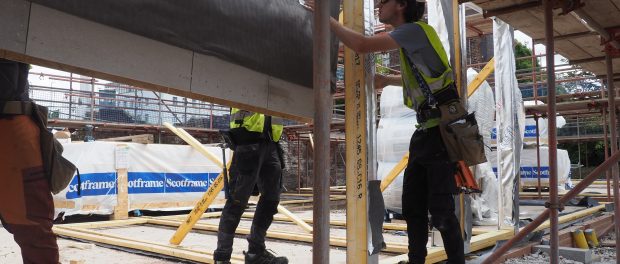A joined-up approach to off-site construction could help create more affordable housing in the UK
 Prefabricated wooden trusses being installed on site
Prefabricated wooden trusses being installed on site
Off-site construction methods could provide a much-needed boost to the delivery of more affordable homes in the UK, but the sector needs better cooperation between landlords, developers and support from government at both local and national level.
That is the consensus of a group of social housing experts who took part in a series of roundtable events organised by Saint-Gobain Off-Site Solutions, which has now been collated in a white paper entitled How Should Off-Site Construction be part of the Affordable Housing Toolkit? which has been published on the company’s new online Knowledge Hub.
Attendees from organisations including social landlords, affordable housing architects and investors shared the challenges they faced in building new affordable homes and maintaining existing stock, highlighting issues of dwindling budgets, increased regulation and a complex planning process, as well as problems in the supply chain including a lack of skills and finding suitable products and materials.
Many of the experts said that components made off-site, such as timber and steel frames, panelised wall systems and readymade structural components, were already being widely used in affordable housing developments they were involved in. This approach overcomes some of the planning challenges and poor perception that volumetric category one MMC (Modern Methods of Construction) has faced in the past.
The attendees acknowledged the potential of off-site construction methods for increasing the pace and volume of building, while also bringing benefits of lower environmental impact and warmer homes.
During the roundtables held in Manchester and London, Colin Lafferty, Senior development Manager for social housing provider, Torus, explained the appeal of off-site construction. He said: “I’m constantly talking to my team about MMC and what new innovations are in the market. What else is out there? We need to keep that education going. Hopefully, just normalising the idea of zero bills for residents or near zero bills, the sustainability of the products that we’re creating.”
However, there remains uncertainty around accessibility to new technologies from a supply chain more geared to traditional methods. Helen Spencer, Executive Director of Growth for the Great Places Housing Group, explained:
“A challenge for us is how we engage with our principal contractor supply chain to maximise use of off-site solutions, which we believe to be part of the answer, particularly with sustainability in mind.
“We need to support them to adapt their processes to accommodate some of those materials, some of those products. We are looking at how can we work more closely with the supply chain to breakdown some of those barriers and how that might help us tackle the costs more directly.”
Saint-Gobain Off-Site Solutions says the challenge now is to work with industry stakeholders, particularly affordable housing landlords, to understand how off-site construction can meet their needs and help them overcome issues with funding, planning and finding suitable solutions.
In its white paper, Saint-Gobain Off-Site Solutions lists six key findings, ranging from the reform of planning processes through to increased Government support, include financially.
Explaining the rationale for holding the roundtables, Will Jones, Marketing and Digital Director, Saint-Gobain Off-Site Solutions, said: “We wanted to better understand the role off-site construction could play, and indeed is already playing, in helping to provide more affordable housing. The insight and firsthand experience we got from this engagement process was incredibly valuable and often eye-opening.
“We asked the question How should off-site construction be part of the Affordable Housing Toolkit? The answer we got was It already is… but it could potentially play a bigger role if persistent challenges are addressed.
“These are barriers that manufacturers like Saint-Gobain can help address by working more closely with other stakeholders. But there are also structural issues that ripple throughout the industry that require top-down support and a change in the way off-site construction is perceived.”
The full findings and insight from the roundtables are captured in the white paper available on the company’s Knowledge Hub, a new online resource designed to demystify off-site construction and raise awareness of the technology as a way of helping to address the UK’s housing crisis.
Saint-Gobain Off-Site Solutions is a major player in the sector and has collated a series of especially commissioned white papers, case studies and learning resources, including reports from Government and trade bodies, and made them freely available online on the Hub.
The company hopes the Knowledge Hub will become a valuable resource of information and insight for anybody in the built environment wanting to know more about off-site solutions, as well as those currently working in the sector or interested in understanding more about off-site construction and its potential, such as architects, planners, students and academics.
Jones continued: “The potential for off-site construction methods in the UK is huge, but all too often it becomes obscured by a lack of information or disinformation. We believe that our Knowledge Hub will provide stakeholders and interested parties with vital information, clarity and real-life case studies to set the record straight on the contribution that off-site construction is already making in the UK housing sector and the opportunity for the future.”
The Saint-Gobain Knowledge Hub can be found at https://offsite.co.uk/knowledge-hub/ and the full white paper is available to download at https://offsite.co.uk/whitepaper-how-should-off-site-construction-be-part-of-the-affordable-housing-toolkit/
To find out more about Saint-Gobain Off-Site Solutions, please visit: offsite.co.uk


